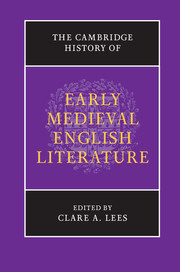Book contents
- Frontmatter
- Contents
- List of Illustrations
- List of Contributors
- Acknowledgements
- List of Abbreviations
- Introduction: literature in Britain and Ireland to 1150
- I WORD, SCRIPT AND IMAGE
- II EARLY ENGLISH LITERATURE
- III LATIN LEARNING AND THE LITERARY VERNACULARS
- 19 In measure, and number, and weight: writing science
- 20 Legal documentation and the practice of English law
- 21 Latinities, 893–1143
- 22 The authority of English, 900–1150
- 23 Crossing the language divide: Anglo-Scandinavian language and literature
- 24 European literature and eleventh-century England
- 25 Gaelic literature in Ireland and Scotland, 900–1150
- 26 Writing in Welsh to 1150: (re)creating the past, shaping the future
- Bibliography
- Index of manuscripts
- Index
25 - Gaelic literature in Ireland and Scotland, 900–1150
from III - LATIN LEARNING AND THE LITERARY VERNACULARS
Published online by Cambridge University Press: 05 February 2013
- Frontmatter
- Contents
- List of Illustrations
- List of Contributors
- Acknowledgements
- List of Abbreviations
- Introduction: literature in Britain and Ireland to 1150
- I WORD, SCRIPT AND IMAGE
- II EARLY ENGLISH LITERATURE
- III LATIN LEARNING AND THE LITERARY VERNACULARS
- 19 In measure, and number, and weight: writing science
- 20 Legal documentation and the practice of English law
- 21 Latinities, 893–1143
- 22 The authority of English, 900–1150
- 23 Crossing the language divide: Anglo-Scandinavian language and literature
- 24 European literature and eleventh-century England
- 25 Gaelic literature in Ireland and Scotland, 900–1150
- 26 Writing in Welsh to 1150: (re)creating the past, shaping the future
- Bibliography
- Index of manuscripts
- Index
Summary
Sometime in the second half of the tenth century, the ‘chief poet of Ireland’, Cinaed ua hArtacáin (d. 975), composed a poem that praised the Scandinavian king of Dublin, Óláfr Sigtryggsson, known to the Gaels as Amlaíb Cuarán. The poem was concerned with a place, Achall, not far from Dublin, a site which, in its placement in the landscape, confronted the Irish royal site of Tara, and which now housed a church dedicated to St Columba.
Amlaib Átha Cliath cétaig
rogab rígi i mBeind Etair;
tallus lúag mo dúane de,
ech d’echaib ána Aichle.
[Amlaib of Ath Cliath the hundred-strong,
who gained the kingship in Bend Etair;
I bore off from him as price of my song
a horse of the horses of Achall.]
Amlaíb had, of course, earlier in his career been king in Scandinavian York. He was a Christian, having taken baptism at the hands of the English king, Edmund. He would die a pilgrim and penitent on the Hebridean island of Iona, in 980. Cinaed ua hArtacáin’s kinsman, Fiachra, was prior of Iona (d. 978); the abbot of Iona, who died the same year as Amlaíb, was Mugrón. He was himself a poet, who had written litanies, devotional poetry and also a praise poem for the Irish king of Tara, an erstwhile ally of Amlaíb Cuarán. This nexus of a Scandinavian king in Dublin and the Hebrides, political and literary relationships across the Irish Sea, chief poets and clerical poets, is one we will return to periodically in this chapter exploring the diversity and richness of the literature of Ireland, and to a lesser extent Scotland, during the period 900–1150.
- Type
- Chapter
- Information
- The Cambridge History of Early Medieval English Literature , pp. 637 - 659Publisher: Cambridge University PressPrint publication year: 2012
- 1
- Cited by

